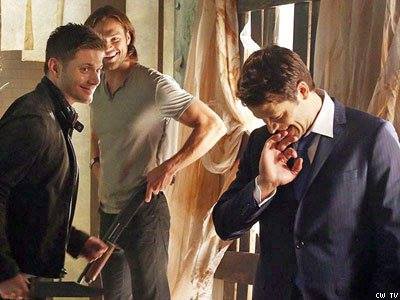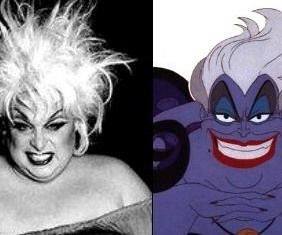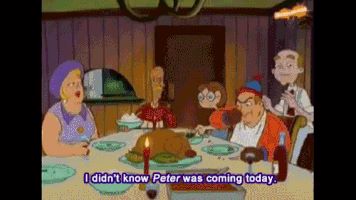
Is it really queerbaiting?
A Brief History of LGBTQIA Censorship in Mainstream Cartoons
by Chloe Spencer
I remember being at a party one night—okay, yes, your laughter can stop now. I actually do go to parties and I like to be social every once in a while. Anyways, I remember going to this party and talking to someone about Yuri on Ice. This person admitted that they loved the show, but laughing, said something along the lines of this:
“There is so much queerbaiting in that show, it’s ridiculous.”
What exactly is queerbaiting? According to fanlore.org, “queerbaiting” is a term used to describe the attempt by canon creators to woo queer fans and/or slash fans, but with no intention of actually showing a LGBT relationship being legitimized on screen.

Queerbaiting can be found everywhere in our media. In ABC’s Once Upon a Time, the relationship between characters Regina Mills and Emma Swan is called queer bait, and TNT’s Rizzoli and Isles also plays with the lesbian subtext between the main characters. The newly released Harry Potter and the Cursed Child has been accused of queerbaiting, as well as the show Supernatural. And who could forget all the bi-shounen animes such as Free, Haikyuu, and Kuroko no Basuke which constantly and purposely queer bait their audiences and make fun of gay stereotypes? In queerbaiting shows, characters are depicted as more intimate than friends: they sleep together in the same bed, they caress and touch each other affectionately, and they plan their lives around each other, just as couples do. As the audience, we grow to love and accept these characters as a couple, but the writers have no intention of letting the couple consummate their relationship. Instead, they’re stuck in “no-homo” hell. Queerbaiting makes a mockery of gay and bisexuals’ sexualities, it’s exploitative, and by not allowing the couple to consummate their relationship on screen, it reinforces that heterosexuality is the norm. Also, it’s just straight up teasing, and no one likes to be teased; that’s just mean.
Evidently I’m well aware of queerbaiting and how harmful it is, but I don’t think that Yuri on Ice is queerbait. As you may know, I wrote an opinion piece about homophobia in the anime fandom that has surfaced in response to the success of Yuri on Ice, and in that piece, I happen to discuss the cultural context of the show. Given that I arguably did a lot of research on the show, I was strikingly stupefied by this partygoer’s comment.
“Really?” I asked, my eyes wide with disbelief.
“Uh, yeah,” this person responded.
I awkwardly shrugged this comment off—everyone is entitled to their own opinion, right? And maybe this person didn’t read a lot of articles about the show (which have consistently referred to the anime’s main characters as gay), so I didn’t think it was fair to jump on them when I had a different level of knowledge. Plus it’s not exactly cool to argue about anime in front of your peers who have only a passing interest in the subject. So I let it go.
But the issue of “queerbaiting” resurfaced. This time, I was scrolling through Facebook, reading an article by Comicbook.com about Dark Horse’s comic sequel to The Legend of Korra. The released preview picked up right where the original series had left off. As many fans of the series know, the romantic relationship between the main heroine Korra and her friend Asami was confirmed as canon. This article reiterated that Korra and Asami was canon, even including testimonial evidence from a co-creator’s blog.
And yet: doubt and criticism from the fandom.
Top comment (349 likes) on this article stated: “The whole relationship was nothing but fan service. Neither Korra nor Asami ever showed any attraction to other females in the series before and we’re supposed to believe that they’re both lesbians all of a sudden.”
“Bisexuality exists…” one commenter pointed out to which another commenter retorted, “Fixed: ‘And they’re both bisexual all of a sudden.’”
Whew. Okay, cartoon and comics fans. Clearly this is a reoccurring problem. We need to sit down and have a long talk—and unfortunately it has to be long because there are a lot of harmful misconceptions that need to be addressed.
First, let’s address the obvious: there are no requirements for being LGBTQIA; none, except that you identify as such. Lesbians and bisexuals do not have to be attracted to all women, or all queer women. Lesbians and bisexuals do not have to have had romantic and sexual relationships with women to be considered legitimately queer. Many lesbians and bisexuals may have had sexual or romantic relationships with partners that weren’t of the same sex—that doesn’t make them any less legitimately queer. To perpetuate that is to contribute to harmful ideas and stereotypes that make coming out for queer women that much worse.
To these commenters, have you ever considered the possibility that Korra and Asami simply didn’t find any other women that they were attracted to? Do you think that Korra and Asami have to consistently demonstrate attraction to other women in order to be legitimized as being queer? And if so, how much? Also, Korra only dated one man in the series and showed no attraction to other male characters—with that logic, is she not-straight by default? Or do you think of heterosexuality as being the default sexuality; that unless proven otherwise, a character is straight?
Another question: do you hold these same ridiculously high expectations for queer women in real life, or only for fictional characters?
Most importantly: please recognize how privileged you are if you think that any LGBTQIA person can openly express and demonstrate their feelings for who they like. Many people do not live in environments where it is safe for them to be out or where they feel comfortable being out.
“Queerbait! Fan service!”
I keep hearing and seeing these words tossed around by people with such poignant hatred and criticism, but now I’m questioning whether or not these people are actually considering what goes into making these shows—and the barriers that writers face.
When we constantly criticize cartoons as being “queerbait” and indulging in “fan service,” we’re forgetting one very important thing: the longstanding marginalization and censorship of LGBTQIA people in the media.
Historically, queer characters were something to be made fun of or criminalized. In the early 1940s to the mid-60s, Looney Tunes’ Bugs Bunny frequently dressed in drag, something he did so that he could escape harrowing situations, but his actions mostly contributed to the comedy of the show. What was funnier than a man in drag? Apparently not much else during these two decades. Snagglepuss, a recurring character on The Yogi Bear Show from 1959-1991, was queer coded, possessing a campy, lisping voice; a frequent stereotype of gay men. (Note: Snagglepuss is now considered canonically gay, not just subtextually gay.) The next major queer coded character is introduced in an 1998 episode of The Powerpuff Girls. The villain Him is a terrifying and demonic character that wears high heeled boots and speaks in a sugary sweet falsetto. In addition to being a cross dresser, he is notable for being the most terrifying villain in the show—transphobic, much?

Actually, there are many queer coded villains in cartoons. If you don’t believe me, just watch a Disney movie. Ursula from The Little Mermaid was inspired by a real-life drag queen named Divine. In The Lion King, Scar is described as being “the weird one” in the family and is actively marginalized by the pride, and also holds queer coded traits.
Arguably, it wasn’t until the advent of Hey Arnold in 1996 that we were introduced to gay characters that were depicted positively—and even then, the creators say they desperately had to sneak past the censors. The effeminate and kind teacher Mr. Simmons is canonically gay, but is in the closet largely because of his homophobic family—this is something explored in the Thanksgiving episode. Eugene, who is a nerdy theatre kid, is also canonically gay—or “proto-gay,” as according to Craig Bartlett, the show’s creator. Whatever that means.

But just because Bartlett was able to subtextually imply that two characters were gay in the 90s doesn’t mean it’s any easier for creators and writers to canonically and openly depict queer characters now. Although there has been tremendous progress made in shows in recent years, that doesn’t mean that LGBTQIA characters are free to be themselves—or even exist, as threats of censorship and show cancellation constantly prevent writers from creating character development.
In the case of The Legend of Korra, other writers also point out how Nickelodeon would have likely censored any attempts for the writers to portray the deepening love between Korra and Asami. Even Bryan Koneitzko, one of the show’s co-creators, said on his blog that “At first we didn’t give it much weight, not because we think same-sex relationships are a joke, but because we never assumed it was something we would ever get away with depicting on an animated show for a kids network in this day and age, or at least in 2010.” 2010 was before the first episode was released, meaning the idea that Korra and Asami being romantically involved was tossed around in the show’s development—and yet, the writers didn’t feel comfortable pursuing that relationship until the finale. Koneitzko further writes, “We approached the network and while they were supportive there was a limit to how far we could go with it, as just about every article I read accurately deduced.” He even admits that he doesn’t feel like the series finale was a “slam dunk victory” for queer representation, but hoped that it made things for other shows easier.
Now let’s jump to August 2014, when Adventure Time voice actor Olivia Olsen confirmed that her character, Marceline the Vampire Queen, had been in a relationship with Princess Bubblegum at one point in time. Why couldn’t they put it in the show? Because in some countries where Adventure Time airs, same sex relationships are illegal. Later Olson tweeted that she “liked to make things up.” Bubblegum and Marceline’s relationship has been controversial even before this incident. In 2011 Mathematical, an online show that went behind the scenes of Adventure Time, discussed the lesbian subtext in the infamous “What Was Missing” episode. The video was later taken down, and Fred Seibert, one of the show’s producers, said that “In trying to get the show’s audience involved we got wrapped up by both fan conjecture and spicy fanart and went a little too far,” and also claimed that neither Cartoon Network nor the Adventure Time staff had anything to do with the video being taken down. Suspicious? Undoubtedly so. It wasn’t until 2015, with the release of the Adventure Time miniseries Stakes, that Marceline’s intimate relationship with Bubblegum was deeply explored again.

In recent years, Cartoon Network has seriously cracked down on its writers. In 2014, Cartoon Network censored what would have been the network’s first gay kiss on the show Clarence. Steven Universe, a show frequently celebrated for its groundbreaking LGBTQ characters and content, has also unfortunately succumbed to instances of censorship—the UK broadcast of the episode “We Need to Talk,” had cut clips of Pearl and Rose romantically dancing. In other countries, episodes of the show have also been subject to heavy censorship because of its depiction of characters. Ratings systems in other countries as well as Cartoon Network’s executive decisions have undermined what Steven Universe so fervently and authentically attempts to address.
As evident from Cartoon Network’s problems in the UK, LGBTQ censorship isn’t just limited to the United States. Yuri on Ice has been accused of queerbaiting, but in a country such as Japan, which has neither legalized same-sex marriage nor made legislation to protect LGBT people from discrimination, it’s not hard to imagine that the show has been subjected to heavy censorship. Although it is difficult to find accurate sources for this information, voice actor Suwabe Junichi allegedly said that the show “barely passed” censorship laws. In episode seven of the series, Yuri and Viktor kiss, but the kiss is censored, and even though it was confirmed by the show’s creator Kubou Mitsurou, many viewers are still quick to label the show as queerbait.
Oh, and TV censorship of queer content isn’t just limited to sexually active characters—burger-loving Jughead, a canonically asexual character in the Archie comics, had his orientation erased on the CW’s Riverdale, despite actor Cole Sprouse’s attempts to convince the show’s writers to preserve his character’s identity.
For every stride creators make in LGBTQIA issues, they are met with backlash, even if they aren’t censored. In July 2016, The Loud House made history for having the first gay married couple ever depicted on Nickelodeon, and there were reports that parents prevented their children from watching the show.
What is my point in presenting this condensed history to you? I’m arguing that the next time you think about calling a show “queerbait” or accuse it of catering to its fans that you objectively think about what barriers still exist for the LGBTQIA community and content creators. Clearly, there are still many challenges for writers to overcome in terms of presenting LGBTQIA characters and themes authentically and positively. Don’t just go calling a show “queerbait” because you don’t understand that censorship, even in today’s society, is a very real and serious threat to creators. Stop being frustrated with content creators all the time—you might be, and are very likely, attacking the wrong people.
Although queerbaiting is definitely real in many circumstances, not every show is actively trying to queerbait its audience—often writers are caught in a complicated web of censorship and other restrictions. Writers may be actively and desperately trying to avoid queerbaiting and present characters authentically, but simply can’t because of the red tape.
My advice to you is that if you are concerned that shows are queerbaiting, you challenge that: work to change censorship guidelines, reach out to networks and their executives if possible, and most importantly, support your creators and their shows. Shows like Loud House, Steven Universe, Yuri on Ice, and Clarence need the support of a large audience in order to keep doing what they’re doing. When it comes to television on major networks, change certainly comes—but unfortunately, only if we are patient.

